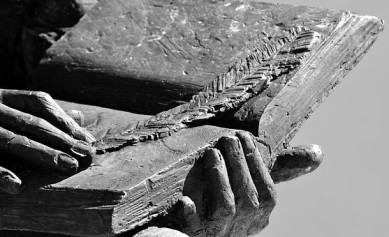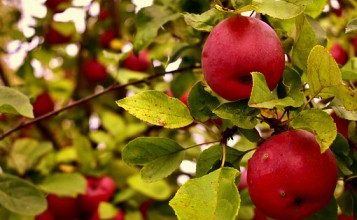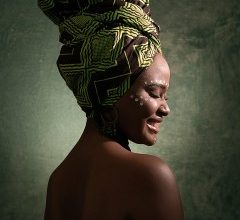
The Statue of the Virgin at Granard Speaks by Paula Meehan criticizes the social and religious institutions that work to oppress multiple factions of the society, through an established method of breathing life into the inanimate and the immobile. However, the poem gives its iconographic narrator’s conventional implications an unanticipated twist. The viewpoint that Meehan’s statue supports is hardly Christian. Ironically, the poet takes aim at what she perceives to be an ugly, cruel, and brutal religion—one that (at least indirectly) led to the death of the 15-year-old who came to give birth at the statue’s feet—using the most revered image of Catholicism, the Virgin Mary.
The Statue of the Virgin at Granard Speaks | Analysis, Lines 1- 7
It can be bitter here at times like this,
November wind sweeping across the border.
Its seeds of ice would cut you to the quick.
The whole town tucked up safe and dreaming,
even wild things gone to earth, and I
stuck up here in this grotto, without as much as
star or planet to ease my vigil.
The first verse sets the bleak and cold tone of the poem. The ‘bitter’ winds and the ‘seeds of ice’ floating give the entire atmosphere a dense and chilling tone, implying desolation and dreariness. The reference to agriculture sparks a tone of jealousy within the statue which complains that it is ‘stuck up here in this grotto’, perhaps placed arbitrarily without much significance. There is a sense of isolation in the wish for a ‘star or planet to ease’ her loneliness. This is where the poet is introducing her anti-ecclesiastical ideologies into the poem, through reference to astrology and belief in the stars tied to a sacred figure in the religion.
The Statue of the Virgin at Granard Speaks | Analysis, Lines 8 -19
The howling won’t let up. Trees
cavort in agony as if they would be free
and take off — ghost voyagers
on the wind that carries intimations
of garrison towns, walled cities, ghetto lanes
where men hunt each other and invoke
the various names of God as blessing
on their death tactics, their night manoeuvres.
Closer to home the wind sails over
dying lakes. I hear fish drowning.
I taste the stagnant water mingled
with turf smoke from outlying farms.
The Northern Ireland border is not far from Granard. A strong howling wind with ominous hints was coming from that direction. The North’s theological conflict and its appropriation of God in favor of carrying out its murderous tactics immediately come to mind, along with all the slaughter and horrors associated with it.
One phrase that also strikes the reader as out of place is ‘the various names of God’. If there was any question regarding the statue’s religious orientation, this suggests a highly pluralist (or possibly atheistic) view of religion. But when she asserts that men merely pray to God to justify their killings, she betrays a sense of contempt towards the institutionalized nature of religion as humans practice. The statue is highly aware of her surroundings at the same time. She talks about lakes that have stagnant water, dying fish, and turf smoke pollution. In contrast to the previous killings, it appears like she takes part in this one because she can taste the murky water and hear the fish perishing. This is the first illustration of the statue’s close relationship with nature, which she will further emphasize throughout the poem. Meehan’s poetry has a strain of environmentalist concerns as perpetually woven in with the other issues she attempts to underline.
The Statue of the Virgin at Granard Speaks | Analysis, Lines 20 – 29
They call me Mary — Blessed, Holy, Virgin.
They fit me to a myth of a man crucified:
the scourging and the falling, and the falling again,
the thorny crown, the hammer blow of iron
into wrist and ankle, the sacred bleeding heart.
They name me Mother of all this grief
though mated to no mortal man.
They kneel before me and their prayers
fly up like sparks from a bonfire
that blaze a moment, then wink out.
The statue turns the perspective outward and tries to place herself as the world views her. However, she holds the inherent violence that the Christian narratives propagate. This is shown through the way she describes the crucifixion with physical and visceral details instead of abstract notions such as love and sacrifice and divinity. She implies that the thought of a mother who conceives without intercourse is perverted and ill, as is this Christian obsession with death. The fact that the town’s residents are frequently referred to as “They” by the statue has also certain significance. ‘They’ are virtually undetectable and faceless. The fact that the statue defies both God’s compassion and his very own existence in the last lines of this verse, only makes her lack of empathy for them more unsettling. The prayers and ineffective wishes at her feet are regarded coldly and as temporal.
The Statue of the Virgin at Granard Speaks | Analysis, Lines 30 – 35
It can be lovely here at times. Springtime,
early summer. Girls in Communion frocks
pale rivals to the riot in the hedgerows
of cow parsley and haw blossom, the perfume
from every rushy acre that’s left for hay
when the light swings longer with the sun’s push north.
However, the poem takes a nostalgic turn as the statue reminisces about the lovely times in the grotto that are no longer there. The beauty of nature is unsurpassable by the ephemeral existence of humans and their ever-so-fleeting youth. This verse expresses deep yearning and longing in the statue, away from the dreariness of the current reality.
The Statue of the Virgin at Granard Speaks | Analysis, Lines 36 – 42
Or the grace of a midsummer wedding
when the earth herself calls out for coupling
and I would break loose of my stony robes,
pure blue, pure white, as if they had robbed
a child’s sky for their colour. My being
cries out to be incarnate, incarnate,
maculate and tousled in a honeyed bed.
The imagery in this verse turns more sexual and earthy, as the statue is leaning towards the ancient traditions of the land and the religion of nature. The statue is holding the conceptions that these people hold as childish and naive, that she is merely a drawing on paper. This image defies the pure and sanctimonious picture that the Christians hold for Virgin Mary, and leans more towards the lush and sensual nature of femininity. The idea of female sexuality evokes more disturbance than the brutal and bloody crucifixion of Jesus.
The Statue of the Virgin at Granard Speaks | Analysis, Lines 43- 49
Even an autumn burial can work its own pageantry.
The hedges heavy with the burden of fruiting
crab, sloe, berry, hip; clouds scud east
pear scented, windfalls secret in long
orchard grasses, and some old soul is lowered
to his kin. Death is just another harvest
scripted to the season’s play.
The statue nods at the oncoming autumn and the nature burdened with fruit. She acknowledges the ritualistic and somber nature of an autumn burial. Death and autumn go hand in hand. Life is followed by death and that is the cycle of life.
The Statue of the Virgin at Granard Speaks | Analysis, Lines 50 – 55
But on this All Souls’ Night there is
no respite from the keening of the wind.
I would not be amazed if every corpse came risen
from the graveyard to join in exaltation with the gale,
a cacophony of bone imploring sky for judgement
and release from being the conscience of the town.
However, the reader is pulled back into the bleakness of this icy night that the statue is currently standing under. This statue evokes the image of corpses rising from the ground to celebrate themselves, perhaps in an attempt for the people to come face to face with their actions and feel guilt. The statue is somehow calling out the people to take responsibility, to feel this on their conscience. This further adds to the doubt cast upon religion.
The Statue of the Virgin at Granard Speaks | Analysis, Lines 56 – 67
On a night like this I remember the child
who came with fifteen summers to her name,
and she lay down alone at my feet
without midwife or doctor or friend to hold her hand
and she pushed her secret out into the night,
far from the town tucked up in little scandals,
bargains struck, words broken, prayers, promises,
and though she cried out to me in extremis
I did not move,
I didn’t lift a finger to help her,
I didn’t intercede with heaven,
nor whisper the charmed word in God’s ear.
Whatever plea the statue had towards the townspeople in the previous passage, it is completely overshadowed and proven worthless in this verse. The statue, in a tone that alternates between pity and fury, describes a young girl who sneaks into the statue’s grotto to give birth. The girl’s narrative and Mary’s story are startlingly similar to one another. Like Mary, she is young, her pregnancy is illegitimate, she has no “midwife, doctor, or friend to hold her hand,” and if the village knew the details of her pregnancy, they would reject her. She clearly intends it to serve as a reminder of the small-mindedness and ignorance of the community that contributed to this catastrophe. The fifteen-year-old dies in childbirth, unlike the Virgin Mary.
The statue’s short-punctuated condemnation of herself presents multiple questions to the readers. Is the statue unwilling or unable to help the girl? What does it mean that even the statue’s prayers are unanswered? However, the continuous questioning of God levels a heavy condemnation towards the religion and its followers, whose views seeped into so much misogyny and blind faith that they led to the death of a young girl. Is it, then, Mary’s fault for leading to this point, since she brought the religion into existence?
The Statue of the Virgin at Granard Speaks | Analysis, Lines 68 – 74
On a night like this I number the days to the solstice
and the turn back to the light.
O sun,
centre of our foolish dance,
burning heart of stone,
molten mother of us all,
hear me and have pity.
The words of the statue transition into a lament after this dramatic conclusion. She addresses the sun as the “molten mother of us all,” rejecting the transcendent God while reinforcing the statue’s faith in the supremacy of nature. Even though the statue begs for mercy and compassion for the creatures who take part in life’s “foolish dance,” she describes the sun as having a “burning heart of stone,” which gives little cause for optimism. The usual vocabulary for a merciful character, gentle and warm, does not actually represent the sun’s heart. The ultimate law of the cosmos is nature, which is both beautiful and cruel; it is highly probable that the statue’s plea will go unanswered. Her pleas to nature are a direct parody of the prayers she gets at her feet, which create ironic yet sad imagery.
This poem is about the actual death of Ann Lovett (6 April 1968 – 31 January 1984), who passed away immediately after giving birth next to a grotto. Her little boy also passed away at the same time, and the discussion about abortion and women giving birth outside of marriage was stoked by her tragedy. It’s important to remember that Ann Lovett experienced abuse from her own family.
Catholics and other Christians mark All Souls’ Day, also known as the Commemoration of All the Faithful Departed and the Day of the Dead, on November 2 each year as a day of prayer and commemoration for the souls of those who have passed away. Paula Meehan’s choice to include this day in her poem, therefore, makes perfect sense.
Given the poem’s scathing critique of Christianity, it is hardly surprising that Meehan is an ex-Catholic herself. Her apparent sympathy with the more antiquated, paganism-based religions, however, tempers an otherwise dismal outlook. Humans are violent, homicidal, death-obsessed, and uneducated; God is uncaring or nonexistent; and the statue is powerless, worn out, and bitter. Nevertheless, the natural cycle continues in all of its horrifying beauty. Even while Meehan says there is little possibility that our “molten mother” will feel compassion for us, there is one consolation: the sun will shine on us all equally hot. Life is unpredictable and uneasy, however, it is fair.


